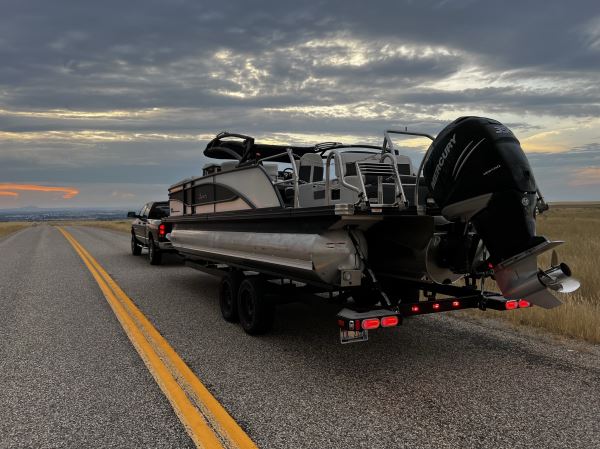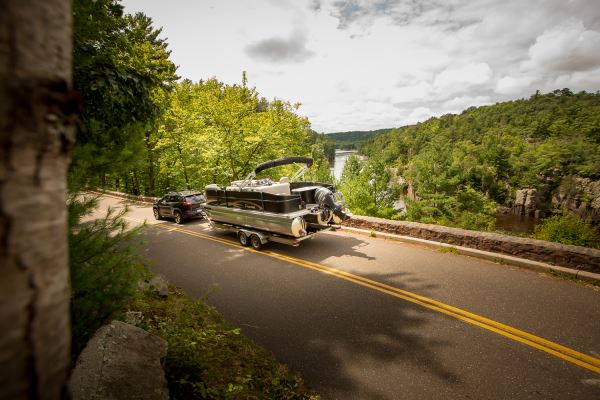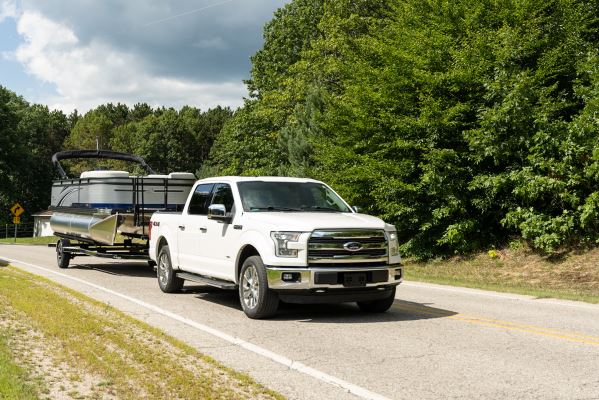 It can be a little nerve-wracking to a new boater to tow the vessel, but with the right amount of preparation and practice you’ll get the hang of it. Boat trailer breakdowns do happen more than you might think, so this is where the preparation part comes in.
It can be a little nerve-wracking to a new boater to tow the vessel, but with the right amount of preparation and practice you’ll get the hang of it. Boat trailer breakdowns do happen more than you might think, so this is where the preparation part comes in.
Boat U.S. reports that over three-quarters of its calls for help on the road are for trailer breakdowns, while the rest of calls are related to problems with tow vehicles. To get you the confidence you need to tow your pontoon or deck boat safely, here are 10 tips to get you started.
1 The Right Vehicle?
With a trailer hitch installed on your vehicle, you might be able to tow your boat a short distance without any problems, but that doesn’t mean your vehicle is necessarily safe to take on long road trips. Look at the vehicle combination more carefully. The undersides of both the trailer and the towing vehicle should be very close to parallel with the road whenever towing.
Check the trailer’s tongue weight, especially if you see the rear of the vehicle body “squatting.” If the tongue weight is not around seven to 10 percent of the gross weight of the entire trailer, then it’s likely you’re not using a good towing vehicle. An easy way to check is to drive the trailered boat to a commercial truck scale, many of which allow you to weigh your trailer for a small fee. When you arrive at the scale, drive your towing vehicle up to the scale with your trailer still hooked up, but leave the trailer’s wheels off the scale. Record the displayed weight. After that, drive the trailer away from the scale, unhook it from your towing vehicle, and drive the towing vehicle by itself onto the scale. Record that weight and subtract that number from the previous recorded number; now you have your tongue weight. Finally, divide the tongue weight by the gross weight of the trailer with the boat on it, and you will be able to tell if your vehicle is safe to use for towing the vessel on long road trips. The best recommended vehicles for towing are generally around the size of a half-ton or larger.
2 Ready To Tow
It’s critical to have your vehicle outfitted with the right features before towing anything so large, which is where mirrors come in. They may be factory-installed or aftermarket mirrors, but they must be large enough for you to fully see your trailered boat in the rearview with the surrounding objects and oncoming traffic. Adjust them for high-quality all-around visibility. In addition, check the condition of your hitch; make sure it’s securely bolted to your vehicle’s frame and that it’s not rusty. Rust streaks are a sign of decay, and if the hitch gets too rusty, it will fail. To prevent hitch failure, WD-40 or similar products can be sprayed on the hitch.
3 Inspect Tires
To help prevent tire failure, always check tire pressure. Recommended tire pressure is printed on the sidewall. Low pressure causes heat buildup and flexing of the tires, which leads to quick, premature failure. Also check for uneven or unusual wear patterns in the tire tread; the tread will tell you whether or not the tires have been installed correctly or have manufacturing defects. Cracks will tell you the tires are worn from age and ultraviolet (UV) exposure. Replace any and all tires that have unusual bulges, cracks, bounces, or wobbling tread. Over time, have the tires balanced to lengthen life and prevent enroute breakdowns.
 4 Inspect Bearings
4 Inspect Bearings
Another notorious en route failure on trailers is their wheel bearings, and it’s normally caused by improper adjustment, lack of lubrication, and dirt and water contamination. Before your trailer’s inaugural run of the boating season, take apart and clean the bearings, and inspect them for symptoms of wear and overheating. Discoloration of the bearing’s race normally means overheating, and that’s when it’s time to replace it. For further inspection, jack the trailer up and give the tire a spin. It should move freely without any obvious noise. With that, check the grease on the bearings and add some if necessary.
5 Inspect Axles
Axles fail due to corrosion inside the axle tube, which happens in the long run, but you should still on a frequent basis look for rust stains or decay beneath all painted surfaces. Another way to check the metal’s condition is to tap it with a hammer; good metal clangs while rotten metal thumps. Remove rust by scrubbing it with an angle grinder or wire brush. Also, coat the surface with POR-15 or a similar product, and then paint the top coat. However, that only fixes outside rust. If the inside of the axle is rusty as well, have it replaced in the near future.
6 Check Safety Devices
After checking the wheels, ensure your trailer lights are working. Replace any burned-out bulbs and replace lenses if chipped or cracked. With that, keep an eye on the condition of the trailer’s electrical plugs. DO NOT use the trailer hitch as a ground; it’s not a reliable connection! A bad connection to the tow vehicle will cause a flickering light. Of course, also crank the trailer winch strap to the bow eye and tighten all ratchet straps to the trailer frame. Tighten them all as much as possible.
7 Distribute Weight
Before you set off, it’s important to always distribute the weight of your boat evenly, both side to side and front to back. That means arranging objects sitting on board the boat so that they’re not all crammed in one place. Such objects can include water skis, wakeboards, ropes, anchors, and other equipment. It’s generally best to limit heavy cargo to your towing vehicle, but if you must store heavy objects in your boat, always disperse them evenly on board to reduce the chance of the boat pulling off. DO NOT store various objects in one specific location on the boat to add weight to or remove weight from the trailer tongue. Objects can and will shift around to different parts of the boat’s storage areas when accelerating and decelerating, significantly altering the integrity of the trailer.
 8 Walk-Around Inspection
8 Walk-Around Inspection
After performing all pre-trip checks, perform a walk-around inspection of the trailer as a way to double-check the overall working condition. While walking around, look at the trailer from top to bottom in small (i.e. three-foot-wide) sections to be sure that the boat is not tilting and that all lights work. At the same time, touch and feel the winch and ratchet straps around the boat to ensure tightness and security.
9 Increase Alertness En Route
When driving, the most important measure to take is to allow more stopping distance, as the boat on the trailer almost doubles the weight of the entire entity. Avoid sudden starts, stops, or turns that can throw off trailer stability, and always engage a low gear when driving downhill. Such movements can also throw the boat off and cause a serious accident if accelerating or decelerating quickly enough.
While on your way, a good rule of thumb is to check the trailer after one, 10, and 100 miles in case a strap comes loose. It’s also important to carry a spare tire compatible with your trailer, a jack and jack stands, wheel chocks, a lug wrench compatible with the wheels, and a tire gauge. However, keep your mind off of it as much as possible when behind the wheel. Proper upkeep of your trailer is sure to help reduce driver stress.
10 Don’t Take Boat Towing Lightly
We can now understand why preparing to safely trailer your boat on a long road trip is an involved process. Trailers have complex mechanisms (especially in the wheels and axles) that are all interconnected. When one component fails, damage to the trailer or hitch can prove costly. That’s why just because your vehicle is powerful enough to tow the boat doesn’t necessarily mean that it’s “ready.”
Especially before the beginning of a boating season, it’s important to inspect trailer mechanisms, because the trailer has been sitting in storage for a long time. Not all of these checks should be performed before every single trip, but you as a boater should still be mindful throughout the season. What absolutely must be done before every trip, though, is balancing the boat’s weight and inspecting important safety devices, including the winch, straps, and lights. This is not a process to be taken lightly, because you don’t want to be spending vacation time broken down on the side of the road.

